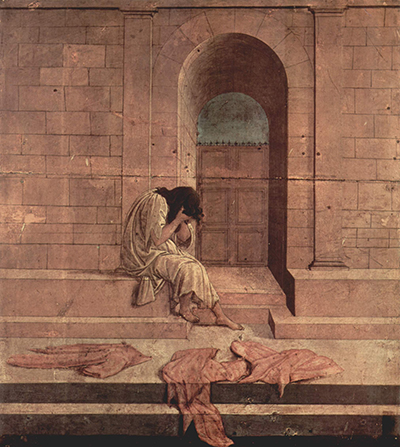The Outcast is a painting which formed part of a larger series which became known as Scenes from the Story of Esther. The artworks date from the 1470s, though few of Botticelli's paintings have ever been dated any more precisely than that. Some of this series was actually carried out by Filippino Lippi, another highly regarded member of the Early Renaissance in Italy.
We find in front of us here a relatively simple composition, with a single figure, head-bowed, sat by themselves. Clothes are strewn by their feet, and a very symbolic gate is closed. They have been banished, it appears, with no offer of assistance coming any time soon. It is rare for Botticelli to work in this way, with bright colour being a common aspect of most of his paintings. Instead, we see here fairly modest tones, reflecting a stone wall with a metal gate at the back, and so sign of life elsewhere. Botticelli was a highly skilled architectural painter, though normally such constructions would not play as important a role in the work as they do here. The individual seems distraught and desperate, believing there to be no chance of salvation and so this is an entirely sombre atmosphere that the artist has created here as we start to wonder more about the circumstances which led up to this moment, and also as to the identity of the figure in front of us. One of the advancements of the Renaissance was in how architectural angles were most accurately depicted and we see examples of that within The Outcast.
There were other titles in this series including Workshop of Esther at the Palace Gate and The Triumph of Mordecai from the Story of Esther, with The Outcast not receiving as much attention as some of the others because of its distinct lack of colour and positivity. There were actually three related artworks titled Mordecai Lamenting ; Esther Faints Before Ahasuerus ; Haman Begs For Mercy In Vain, and Haman, which sat within the overall larger series. Botticelli did work on a number of series of paintings and these were popular with larger institutions who liked to have a consistency between the art within their buildings, normally choosing a common theme and asking a single artist to produce all of them himself.
The Outcast is also sometimes known as La Derelitta, or Mordecai Weeping, which in itself provides us with a few more clues about the piece. This piece was actually originally claimed to have been by Masaccio, but this attribution was later adjusted once a number of discoveries were made in the next few centuries. This particular painting may now reside within the Louvre in France, but we cannot be entirely sure as detail on these individual panels is relatively scarce and they are not generally promoted as major parts of the artist's oeuvre, and so there is less desire to really research them in greater detail. There has also been a common issue with early Renaissance art in terms of precise attributions though this has been improved in recent years thanks to the increased use of science which helps to avoid trawling through centuries of historical opinion to try to decide upon the most likely creator of each particular piece.




